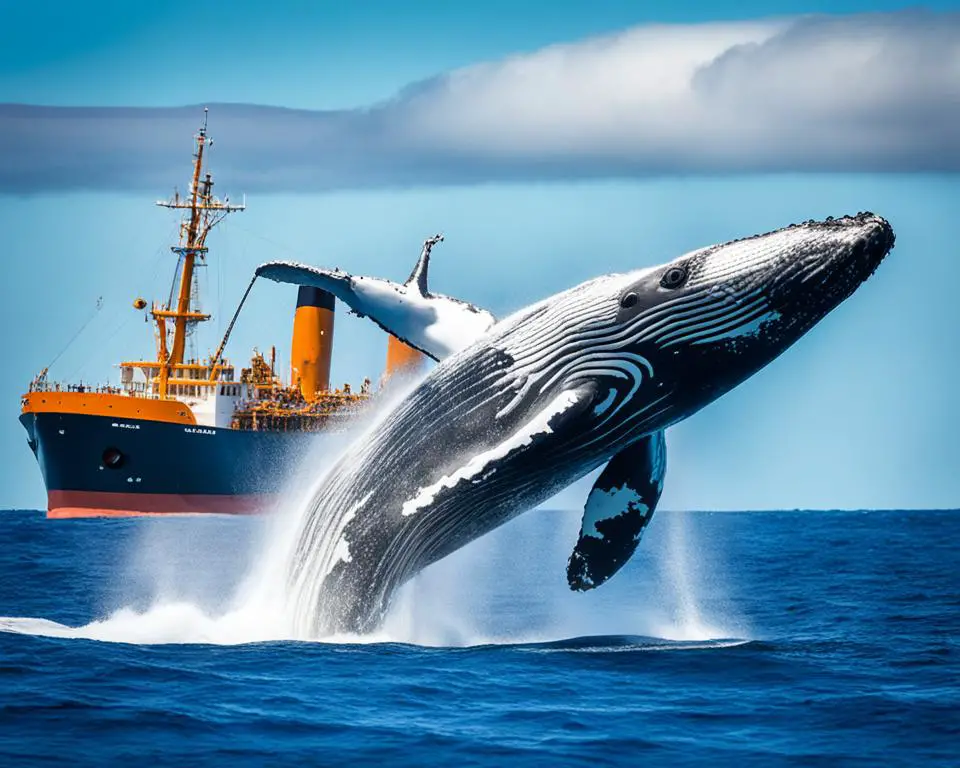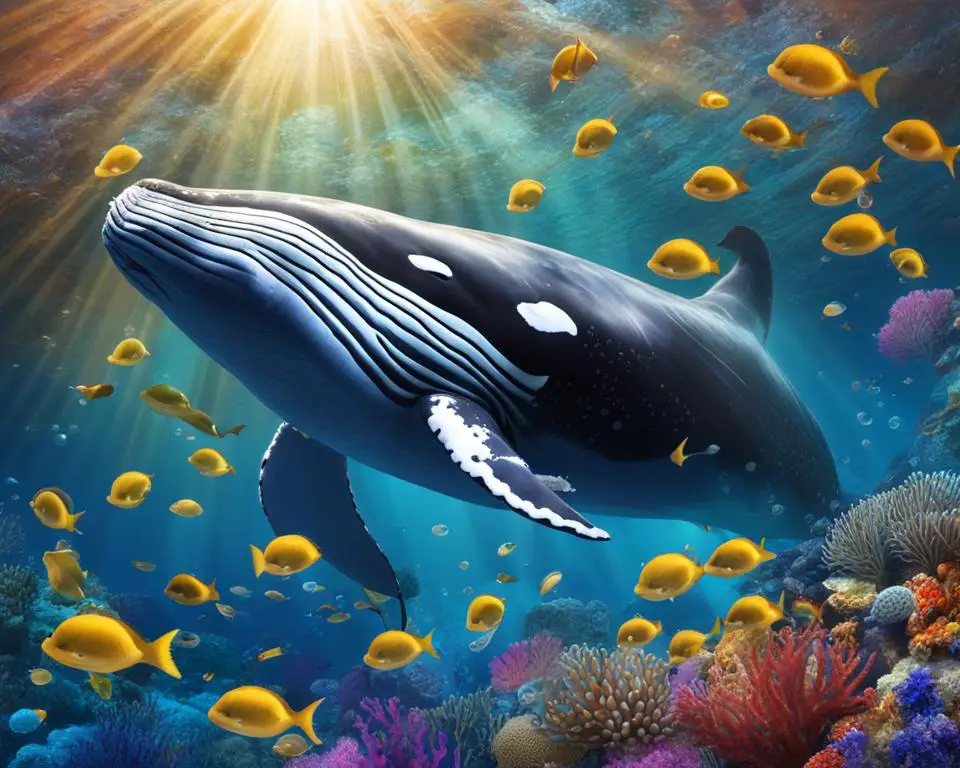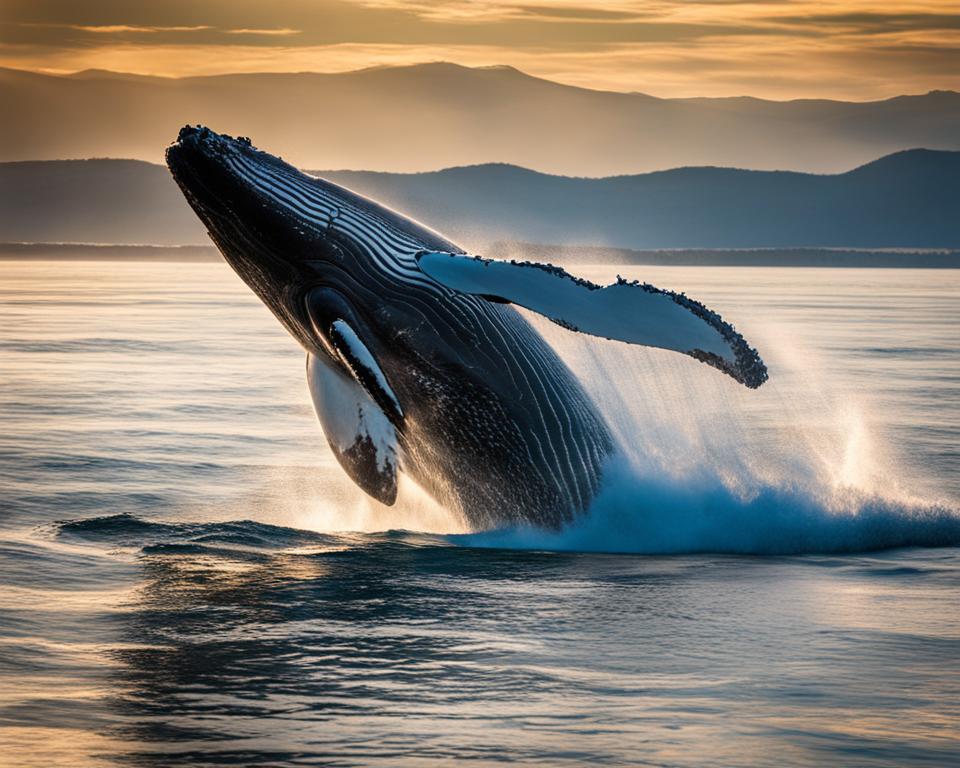Dive into the dynamic realm of marine life where the humpback whales prove to be one of the most fascinating ocean creatures in our global seas. These aquatic behemoths are not just notable for their sheer size but also for their captivating whale songs and extensive migration habits, traversing thousands of miles across the oceans each year. Join us as we unveil the secrets of these gentle giants, from their playful breaches to the haunting melodies that ripple through the deep blue.
As inhabitants of the watery depths, humpback whales grace us with their awe-inspiring presence, inviting us to appreciate and explore the complexity of their existence. Stay tuned as we explore an oceanic world teeming with wonders and discover why the humpback whale holds a special place in the heart of our planet’s biodiversity.
Identifying Humpback Whales: Unique Body Characteristics
When observing the vast expanses of the ocean, one might be fortunate enough to witness the majestic dance of baleen whales. However, recognizing the humpback whale requires an understanding of specific physical traits that make them stand out amongst their marine companions. Their unique body characteristics not only fascinate those involved in marine biology but also serve as essential identifiers for the casual whale-watcher.
The Distinctive Hump and Dorsal Fin
The characteristic silhouette of the humpback whale includes a prominent curvature preceding the dorsal fin—a detail integral to dorsal fin identification. This hump signifies their readiness to dive and is the trademark feature that earned the species its common name. Directly behind this, the relatively small dorsal fin rises, more akin to a knuckle than the prominent fins seen on other species, making it a distinguishable attribute in the realm of marine biology.
Coloration Patterns and the Knobby Head
The humpback’s coloration varies from a dark grey to a blue-black on the dorsal side, contrasting with a paler underbelly that may be solid white or feature a mottled pattern. Adding to the intrigue are the textured knobs, or tubercles, dotting their heads and jaws. These knobs provide another visual anchor for identification and reveal the adaptability of these creatures within their aquatic environment.
Impressive Flipper Size Compared to Body
A spectacle in their right, the whale flippers of a humpback are exceptionally long and can extend up to one-third of its body length—longer than any other baleen whale species. These elongated pectoral fins aid in maneuvering and play a role during the whale’s social displays, emphasizing the complex interaction between form and function that defines these gentle giants.
To further grasp these traits, let’s consider the dimensions of the humpback whale’s definitive features:
| Body Part | Typical Size | Description |
|---|---|---|
| Dorsal Fin | Small | Sits at the peak of the hump, resembling more of a protrusion |
| Coloration | Dark grey to blue-black (dorsal); White to mottled (ventral) | Contrasting hues with unique patterns |
| Flippers | Up to 1/3 of body size | The longest pectoral fins among baleen whales, often with white undersides |
| Head and Jaws | Large and knobby | Heads adorned with distinctive tubercles |
What we witness in the dance of a humpback’s breach or the casual flick of its gargantuan flipper is more than just a moment of aquatic grace; it’s a portal into the diverse morphology that defines marine biology and our continual fascination with these oceanic inhabitants.
The Gigantic Size of the Humpback Whale
Within the realm of the ocean’s giants, the female humpback whales secure their ranking through impressive dimensions both in whale length and weight. Spanning the vast marine territories, these marine giants embody sheer magnitude, with the ability to grow to a staggering 15 meters in length and weigh as much as 30 tonnes. This significant whale size not only commands respect but also underscores the humpback’s capabilities in undertaking prolonged migratory voyages across the seas—a quintessential trait for their survival and propagation.
The table below showcases the average measurements of humpback whale size, and notably how the female humpback whales typically exceed their male counterparts in size, illustrating the common trend of sexual dimorphism among these marine species:
| Gender | Average Length | Average Weight |
|---|---|---|
| Male Humpback Whale | 13-14 meters | 25-28 tonnes |
| Female Humpback Whale | 14-15 meters | 28-30 tonnes |
Indeed, the enormity of humpback whales plays a crucial part in their fascinating lifecycle. It allows these marine giants to thrive in the colossal expanses of the ocean—making every sighting an event of sheer awe and grandeur for whale enthusiasts and the curious onlooker alike.
Witnessing their colossal physique breaking the ocean’s surface or observing their silhouettes gliding beneath the waves, we are reminded of their status as one of the ocean’s true behemoths. The humpback whale’s incredible size is not merely for show; it is a testament to their evolutionary excellence and the adaptability that ensures their continuity within the dynamic tapestry of marine life.
Global Distribution and Population Diversity
Exploring the expanse of our planet’s oceans reveals the extensive global whale distribution, and at the heart of this vast network are the humpback whale populations. With their awe-inspiring journeys, humpbacks grace the myriad marine ecosystems, illuminating our understanding of whale habitats and the critical ecological roles they play.
Worldwide Habitats of Humpbacks
The map of humpback whale populations is a tapestry as diverse as the seas themselves. With 14 distinct global populations identified, these majestic creatures navigate the waters from the polar ice caps to the tropical equator, ensuring the health and balance of marine ecosystems in each region. The intimate connection they share with their habitats underscores the importance of preserving these environments, not just for the whales but for the entire oceanic community.
Oceania Population and New Zealand’s Whales
New Zealand’s rich seas serve as a microcosm for studying the humpback’s wide-ranging habitats. Here, the Oceania population of humpbacks frequents the waters, managed under the Antarctic sector known as Area V. Recognized as Breeding Stock E, these humpbacks are connected to a territorial range extending from eastern Australia to Tonga. Their presence in the region highlights the intricate puzzle of global whale distribution and the multifaceted nature of whale habitats.
Oceania’s humpbacks are a testament to the resilience and adaptability required to thrive across such a broad spectrum of the ocean. A closer look at these populations unveils a complex narrative of migration, breeding, and interaction with diverse marine environments.
Recovery from Whaling: A Historical Perspective
The history of whaling paints a somber picture, once casting vast shadows over the future of humpback whales. It is a history mired in the pursuit of oil and the devastation of endangered species. The scale of the impact was profound, reducing humpback populations in certain regions to mere whispers of their former glory. New Zealand waters, which provided a habitat for these magnificent creatures, were not spared from the harrowing decline.
Whaling Impact on Humpback Numbers
The intensive whaling era, stretching from the 18th to the middle of the 20th century, led to the slaughter of countless humpback whales, many within the idyllic waters of New Zealand. It’s estimated that this relentless hunt reduced the population by an alarming 95 percent, leaving a mere fraction of these ocean giants in the oceans. This drastic decrease underscores an urgent need for whale conservation efforts to facilitate their population recovery.
Conservation Efforts and Population Regrowth
In recent decades, the tide has begun to turn with the implementation of multiple conservation measures. International agreements and the creation of sanctuaries have delivered a beacon of hope for humpback whales. Through such efforts, there has been a slow but steady resurgence in their numbers. The gradual population recovery has been particularly notable in the Eastern Australian population, which contrasts with the more sluggish growth seen among the Oceania humpbacks—a group that includes those in New Zealand.

To illuminate the transformative power of conservation, here is an overview of the improvements observed:
| Conservation Measure | Impact |
|---|---|
| International Whaling Ban | Significant reduction in hunting, allowing for natural population growth |
| Marine Sanctuaries | Safe havens promoting increased breeding and survival rates |
| Public Awareness Campaigns | Enhanced public support and engagement in whale conservation initiatives |
| Scientific Research | Data-driven policies and protections that address specific threats to recovery |
This resurgence is not just a victory for the humpbacks but for the ocean ecosystems that rely on these magnificent creatures. Though the journey of whale conservation is ongoing, the rebound of humpback whales stands as a testament to what can be achieved when humanity commits to the protection of its natural world. The slow, steadfast recovery of these gentle giants continues to strengthen the resolve of conservationists and whale enthusiasts alike, fostering an enduring hope for the future of all endangered species.
Migration Patterns: A Remarkable Journey
The whale migration is a transformative experience that encapsulates the resilience and adaptability of humpback whales. These majestic creatures undertake a marine journey stretching thousands of miles, marking one of the animal kingdom’s longest and most strenuous seasonal travels. The paths they traverse and the behavioral patterns they exhibit during migration are integral for understanding these cetaceans’ life strategies.
Tracking Seasonal Movements
With modern advancements in animal tracking technology, researchers can now gain unprecedented insights into the humpback whales’ migration routes. By following their movements, scientists uncover not only the routes but also the timing and reasons behind their migration. This has significantly contributed to our understanding of the unique challenges they face during their long-distance voyages.
Understanding Migratory Stamina and Distances
The humpback whale’s endurance is put to the test during their migration, with individuals swimming non-stop for periods that could extend up to nine weeks. The distances covered in these migrations can exceed a staggering 8,000 kilometers, highlighting their astonishing migratory stamina. The considerable distances covered are not only proof of physical strength but also a vital aspect of their lifecycle, ensuring the species’ survival through access to varied breeding and feeding grounds.
| Migratory Phase | Starting Point | Destination | Distance (Approx.) | Duration |
|---|---|---|---|---|
| Northward Migration | Antarctica | Tropical South Pacific | 8,000+ km | Up to 9 weeks |
| Southward Migration | Tropical South Pacific | Antarctica | 8,000+ km | Varies |
| Annual Round Trip | Cyclical between feeding and breeding grounds | 16,000+ km | Several months | |
This incredible marine journey undertaken by the humpback whales represents not only the grandeur of nature’s design but also a crucial element for the conservation efforts aimed at ensuring these giants of the sea continue their ancestral routes unimpeded. As we track and marvel at their epic voyages, we are continually reminded of the inherent connection between these gentle giants and the vast, enigmatic oceans they call home.
Whale Watching Favorites: Breaching and Tail Displays
For those who partake in the thrilling activity of whale watching, there is nothing quite as spectacular as witnessing the dramatic leaps and splashes of whale breaching and tail slapping. This remarkable marine animal behavior is not only a feast for the eyes but also a topic rife with scientific intrigue. As these majestic creatures thrust their bodies out of the water in astounding breaches or slap their tails with forceful whacks against the ocean’s surface, they draw both casual observers and dedicated researchers into a world of aquatic mystery and excitement.
Indeed, the reasons behind such dynamic displays continue to pique the curiosity of many. Is it a form of communication, a playful endeavor, or perhaps a method for dislodging pesky parasites clinging to their massive bodies? Theories abound, but one thing remains indisputable—the propensity for humpbacks to engage in tail slapping and breaching behaviors has made them a favorite among whale watchers across the globe.
Observers may note that whale breaching often occurs repetitively, as if the whale is savoring the rush of air and freedom above the waterline. Meanwhile, tail slapping can be heard as a powerful percussion, echoing across the waves and signaling the whale’s presence far and wide. These actions, which may serve multiple functions within the whales’ natural repertoire, are undeniably crowd-pleasers, making them some of the most sought-after spectacles in the world of marine animal behavior.
| Behavior | Description | Common Theories |
|---|---|---|
| Breaching | Humpback whale leaps out of water and lands with a splash | Communication, playfulness, parasite removal |
| Tail Slapping | Whale forcefully brings tail down onto the water’s surface | Signaling presence, stunning prey, social display |
As enthusiasts and researchers alike observe these aquatic acrobats, we are reminded that each breach and each slap is not just a wonder to behold but also a valuable glimpse into the complexities of whale watching and the study of marine life. So, the next time you find yourself gazing out at the ocean’s expanse, keep an eye out for the tell-tale signs of a humpback’s display—it’s an experience that truly embodies the majesty of the sea.
Humpbacks’ Longest Pectoral Fins in the Whale World
Among the numerous marvels of whale anatomy, the humpback whale (Megaptera novaeangliae) is renowned for its impressive pectoral fins, which showcase remarkable marine adaptations. These extended fins are unlike any other in the cetacean family, not only by virtue of their size but also in their functionality.
The majestic pectoral fins of the humpback can span up to one-third of their body length. This extraordinary proportion affords these giants increased agility, allowing them to maneuver proficiently through their aquatic surroundings. In a blend of grace and power, the humpback employs its fins to execute stunning breaches and engage in complex feeding practices.
Understanding the integral role fins play in the humpback’s survival highlights the intricate connection between form and function within whale anatomy. These adaptations not only facilitate their acrobatics and sustenance hunting but also contribute to the thermal regulation and stabilization during their extensive migrations.
The scientific name itself, Megaptera novaeangliae, translates to “big-winged New Englander,” attributing to the expansive nature of their pectoral fins, further connoting their resemblance to wings. It’s a fitting moniker for an animal so adept at navigating both the challenges of the deep and the aerial spectacle of breaching.
Let’s delve into the specifics that make the humpback whale’s pectoral fins so seminal to their identity and survival:
| Pectoral Fin Feature | Description | Benefits |
|---|---|---|
| Size | As long as one-third of the whale’s body length | Maneuverability, feeding, and temperature regulation |
| Shape | Long and slender with a distinctive scalloped edge | Aids in precise movements and dramatic breaches |
| Function | Used in various behaviors, including social signaling and hunting | Communication within species and efficiency during feeding |
The built-in dexterity afforded by these pectoral fins suggests an evolution primed for survival, underpinning the greater narrative of marine adaptations within the humpback species. Recognizing the grandeur of Megaptera novaeangliae and its iconic pectoral fins allows us to appreciate the delicate balance of whale anatomy and the environment it shapes.
The Songs of Male Humpback Whales
In the symphony of the sea, few performances are as riveting as the cetacean songs of male humpback whales. Deep in the realm of marine acoustics, these melodious giants utilize whale communication as a central feature of their mating rituals. Through the haunting songs that travel across the ocean’s expanse, humpbacks engage in a complex practice that blends both art and science.

Courting Rituals Through Melodies
Much like the intricacies of a classical concerto, the mating calls of humpback whales are carefully composed and delivered with purpose. These calls are not merely sounds lost in the current but strategic cetacean songs that serve to allure and court their potential mates. It’s a marvel of nature where the importance of auditory attraction in the underwater courtship is beautifully emphasized, allowing for intimate connections despite the vast distances of their marine habitat.
Regional Differences in Whale Songs
The diversity of whale songs is astounding, varying significantly from one population to another, showcasing regional distinctions akin to dialects in human languages. Beyond a charming attribute, these regional differences in cetacean songs represent a broader narrative of cultural exchange and acoustic diversity. Researchers have observed males from different breeding stocks converging at locations such as New Zealand’s Kermadec Islands to share and modify their songs—a phenomenon that continues to intrigue those studying whale communication.
A closer look into the variances of humpback whale songs throughout the world:
| Region | Song Characteristics | Behavioural Significance |
|---|---|---|
| Oceania | Complex sequences with repeated themes | Courtship and breeding communication |
| North Atlantic | Variable patterns with distinct phrases | Social interactions within the pod |
| North Pacific | Longer songs with elaborate structuring | Mating rituals and territory establishment |
The rich tapestry of sounds created by the male humpback whales reflects a fascinating aspect of marine acoustics—one where music is a medium for complex social interactions and a testament to the adaptive evolution of these oceanic creatures.
The Mystery of the All-White ‘Migaloo’
In the diverse tapestry of marine wildlife, the striking figure of the all-white ‘Migaloo’ stands apart, elevating public intrigue and scientific interest. This albino humpback whale provides rare insight into the phenomenon of albinism within marine mammals and continues to enchant all who gaze upon him. In a world teeming with genetic variation, Migaloo is a beacon of wonder in the deep blue—his uniqueness illustrating the vast diversity of life beneath the waves.
Albinism in Marine Mammals
Albinism, a genetic condition marked by a lack of pigmentation, is as rare in the ocean as it is on land, making Migaloo one of the most extraordinary sightings within the realm of marine wildlife. This striking aberration from the typical dark tones of most humpback whales illuminates the genetic variation that can arise in animal populations, even those as expansive as humpbacks. Migaloo’s surprising appearance challenges our expectations and offers a captivating case study on the diversity within aquatic communities.
Migaloo’s Unique Migration Through Cook Strait
The mystery deepened when this renowned Migaloo humpback whale took an unexpected detour in 2015. Breaking from his usual migratory routine, Migaloo was confirmed to have traveled through Cook Strait, a deviance that adds to his allure and emphasizes the unpredictability within marine wildlife migratory patterns. These wanderings of Migaloo further underscore the significance of tracking animal movements, deepening our understanding of whale behavior and enhancing conservation efforts.
Within the community of those who treasure the ocean and its inhabitants, Migaloo has emerged as an icon of natural beauty and biological intrigue. His rare pigmentation, coupled with his unusual travel paths, not only captivates whale watchers but also propels forward the conversation on the preservation of marine wildlife. Indeed, Migaloo’s ghostly silhouette is a reminder of the ocean’s vast mysteries and the endless discoveries that lie beneath the surface, waiting to be uncovered.
Sporadic Visits and Sightings in the Hauraki Gulf
The waters of the Hauraki Gulf serve as a backdrop for some of the most remarkable rare sightings of marine life, particularly the elusive humpback whales. While not commonly spotted, the occurrences of Hauraki Gulf whales have sparked excitement and interest within the local and scientific communities, offering glimpses of these magnificent creatures outside their typical haunts.
Sightings of these majestic mammals within the Gulf, albeit infrequent, typically happen between August and December when the humpbacks pass by during their migratory journeys. Such rare sightings contribute significantly to the broader narrative of marine conservation, echoing the critical need to monitor and protect these animals in their natural habitats.
How to Report a Humpback Sighting
Encountering a humpback in the waters of the Hauraki Gulf can be a once-in-a-lifetime event, and wildlife reporting plays a crucial role in documenting these rare occasions. By reporting these sightings to dedicated platforms such as Happy Whale, individuals contribute valuable data that aids researchers in tracking whale migrations and understanding their patterns. Such efforts are not only thrilling for the contributor but also essential for marine conservation efforts.
Citizen Science and Whale Identification
The practice of citizen science bridges the gap between everyday enthusiasts and professional researchers, providing a vital stream of observational data on Hauraki Gulf whales. Through platforms geared toward wildlife reporting, passionate individuals can submit their sightings, photographs, and encounters with humpbacks, which then becomes a part of a global effort to catalog and comprehend the mysteries of these sea giants. This collaborative approach not only enriches our collective knowledge but also fosters a community dedicated to the cause of marine conservation.
With every reported sighting, we stitch together a broader understanding of the humpback’s behavior, distribution, and presence in the Hauraki Gulf. This form of engaged stewardship is pivotal in preserving the rare sightings of these awe-inspiring whales, ensuring that future generations may also experience the wonder of their sporadic visits.
The Misconception of the Humpback’s ‘Hump’
Delving into humpback anatomy reveals that the iconic ‘hump’ that one might expect to see is, in fact, a common whale misconception. This misunderstanding stems from the whale’s preparatory posture for diving, wherein its back forms a pronounced arch, which has often been misinterpreted as a static physical feature. To provide clarity, the supposed ‘hump’ is not a permanent anatomical structure, but rather a behavioral trait of these marine mammals as they ready themselves for a deeper descent.
The humpback’s dorsal fin, rather than being an imposing and prominent fin, is a relatively subtle protrusion positioned on the crest of this arch. The fin is followed by a series of bumps leading to the fluke (tail), a sequence that’s characteristic of the marine mammal characteristics unique to the humpback whale. Recognizing such features is crucial for accurate identification and appreciation of the species’ true form and behavior in their natural habitat.
There exists a need to dispel such myths for advancing our understanding and fostering a deeper respect for marine mammal characteristics. Given their role in ecosystems, accuracy in disseminating information about these majestic creatures is paramount. Here’s an illustrative breakdown clarifying the structure of a humpback whale where the aforementioned ‘hump’ phenomenally appears:
| Anatomical Feature | Appearance during Dive | Actual Function |
|---|---|---|
| Arching Back | Creates the illusion of a ‘hump’ | Signaling dive preparations |
| Dorsal Fin | Seen as a modest protrusion on the arched back | Assists in navigation and stability |
| Tail Sequence | Involves series of bumps leading to the tail | Contributes to propulsion in water |
As purveyors of truth about our ocean’s inhabitants, addressing whale misconceptions enriches the collective knowledge. It helps construct a genuine portrayal of the humpback’s morphology and behavior, further bridging the gap between anecdote and empirical data in humpback anatomy. An informed public can then more profoundly appreciate the balletic moves of the humpback whale, understanding that what might be perceived as an anatomical oddity is a testament to the adaptability and intelligence of these incredible marine mammals.
Singing for Survival: Humpback Vocal Ranges
The enchanting and complex world of cetacean vocalizations is a marvel to behold, especially when exploring the haunting songs of the humpback whale. These melodious sounds are not just underwater symphonies; they are essential survival strategies that greatly influence the mating success and marine animal communication within humpback populations. Gaining an understanding of these vocal attributes allows us to appreciate the sophisticated nature of whale communication.
The Purpose of Whale Songs
The male humpback whale’s serenade is perhaps one of the most impressive biological phenomena in regard to marine animal communication. These protracted and voluminous songs serve a multifaceted purpose in the oceanic world, playing an instrumental role in courtship rituals and ensuring successful mating opportunities. Despite their seemingly peaceful nature, these songs are a part of an extremely competitive environment, where each male seeks to outperform others with the allure of his uniquely patterned song.
Comparing Vocalizations in the Animal Kingdom
When compared to other animals, the humpback whale’s vocal range stands unparalleled in complexity and length. These cetacean vocalizations are a testament to the advanced survival strategies harnessed by these marine giants. As researchers delve deeper into the world of animal acoustics, it becomes increasingly clear that humpback whales use their vocal range to manage their social hierarchy and establish territories as they undertake epic migrations through the ocean’s expanse.
In examining the intricate nature of whale songs, let’s reflect on the nuances of these cetacean vocalizations in contrast to other species:
| Species | Vocalization Type | Purpose |
|---|---|---|
| Humpback Whale | Complex Songs | Mating Calls, Social Structure, Territorial Displays |
| Songbirds | Chirps and Melodies | Mate Attraction, Territory Defense |
| Elephants | Rumbles | Long-Distance Communication, Group Coordination |
| Dolphins | Clicks and Whistles | Social Interaction, Echolocation |
The intricate songs of humpback whales continue to intrigue and inspire, providing a stunning auditory display of their distinctiveness among marine animal communication practices. The way these vocalizations influence humpback social behavior and survival strategies is a potent reminder of the complex and interconnected world beneath the ocean’s surface.
Mother and Calf Communication
The deep blue ocean hosts intimate exchanges between humpback whale mothers and their calves, showcasing remarkable calf bonding through specialized vocalizations. This aspect of humpback communication strategies is pivotal for both maternal protection and the development of the young whales. Recognizing the nuanced and private nature of these communications allows us a deeper appreciation of the complex relationships within marine families.
Discreet Vocalizations to Protect the Vulnerable
In the vast marine landscape, where predators lurk, female humpback whales utilize soft and covert sound emission techniques, ensuring maternal protection of their calves. These low-intensity vocalizations are critical, designed to minimize detection by threats such as orcas.
The Role of ‘Wops’ in Mother-Calf Bonding
The unique ‘wop’ sound—akin to a quiet grunt—is a maternal call used to maintain close communication and strengthen calf bonding without drawing the attention of nearby predators. Though seemingly simple, this auditory signal plays a foundational role in the nurturing and safeguarding of young humpbacks during their initial vulnerable phase of life.
Through these humpback communication strategies, we observe the adaptability and intelligence that guide the species’ survival tactics—strategies honed over millennia. As we continue to explore the intricacies of these giants of the sea, we gain insights into their silent symphony of survival.
| Vocalization Technique | Purpose | Key Characteristic |
|---|---|---|
| Low-volume ‘Wops’ | Mother-calf bonding and interaction | Safeguards the calf by keeping communication discrete |
| Deep Rumbles | Communication over longer distances | May be used when calf is farther from the mother |
| High-pitched Chirps | Immediate, close-range communication | Could signal immediate attention or direction |
Indeed, the understated, yet crucial, low-volume ‘wops’ underscore the importance of mother-calf bonding and the natural instinct for maternal protection. These soft-spoken secrets of the ocean whisper about the remarkable connection between mother and calf—a bond woven through the fabric of sound.
‘Whale Culture’ Revealed Through Feeding Techniques
Delving into the aspect of whale foraging behaviors, we uncover the fascinating ‘whale culture’ that manifests in their calculated and communal feeding techniques. This culture, ingrained within the very being of humpbacks, is most prominently observed through their method of cooperative hunting, which not only underscores their intelligence but also the way they share and transmit knowledge across generations and pods.
Bubble-Net Feeding: A Group Strategy
In the study of marine life diets, the humpback whale’s group strategy of bubble-net feeding is a dramatic demonstration of cooperative hunting. Whales work in unison, exhaling air underneath the water to form a rising curtain of bubbles, which serves to corral unsuspecting prey. This ingenuity not only ensures an abundant catch but also exemplifies the complex social bonds that facilitate such collaboration.
The process of bubble-net feeding involves intricate communication and precise timing, which whales have been observed to learn and perfect over time. Humpbacks are seen teaching these methods to their young, ensuring the passage of these survival techniques through generations, demonstrating an extraordinary level of cultural sophistication.
Dietary Requirements and Prey Preferences
The ample diet of humpback whales is critical not only for their survival but also for maintaining their impressive mass. On average, an adult humpback requires over 1.5 tons of food per day, sourced from a variety of nutrition-rich prey such as krill, herring, mackerel, and anchovies. Marine life diets such as these necessitate efficient and sizable foraging behaviors, and humpbacks meet this challenge head-on with their bubble-net feeding technique.
To provide a clearer picture of the breadth of the humpback whale’s diet and the importance of their whale foraging behaviors, consider the following table:
| Prey Type | Significance in Diet | Role in Bubble-Net Feeding |
|---|---|---|
| Krill | Primary source of energy and nutrition | Main target in bubble-net strategy due to dense swarms |
| Herring | Important for protein intake | Often encircled and captured with bubble-nets |
| Small schooling fish (e.g., anchovies, mackerel) | Crucial for diversity of nutrients | Efficiently trapped in the ‘net’ during cooperative hunts |
| Various small fish and plankton | Supplements diet to ensure nutritional balance | Accidentally captured whilst targeting main prey |
In reflecting on the vast and carefully selected marine life diets, we gain insight into the complex behaviors that underpin the survival of these massive yet graceful creatures. The humpback whale continues to inspire with its intelligent foraging, deep-rooted cultural practices, and the role they play in the intricate web of oceanic life.
Conclusion
As our journey through the spellbinding saga of humpback whales concludes, we are left with a deeper appreciation for these oceanic wonders. Their tremendous size, the complexity of their songs, and the innovation behind their feeding strategies, provide us with endless avenues for whale research and marine education. These gentle giants are emblems of nature’s grandeur, offering windows into the depths of marine biodiversity and the importance of conservation. Engaging with the magnificence of humpback whales not only nurtures our human curiosity but fortifies our commitment to preserving the intricate web of life that thrives beneath the waves.
Through ongoing endeavors in marine education and public awareness, humpback whales stand prominently as subjects for nature conservation, encapsulating the pure essence of marine ecosystems. The synergistic efforts of researchers, conservationists, and the public are quintessential in safeguarding these leviathans’ future. By championing their cause, we weave the narrative of conservation into the very fabric of our societies, ensuring that these oceanic icons continue to flourish and inspire awe with their majestic presence in the world’s seas.
The responsibility of nurturing and stewarding the majesty of humpback whales falls upon us all. As stewards of the marine environment, we carry the torch of nature conservation, illuminating the path towards a harmonious coexistence with these remarkable creatures. Through conscientious whale watching, proactive learning, and dedicated respect for their habitats, we can help ensure that humpback whales remain a thriving and integral part of our oceanic wonders for generations to witness and revere.











